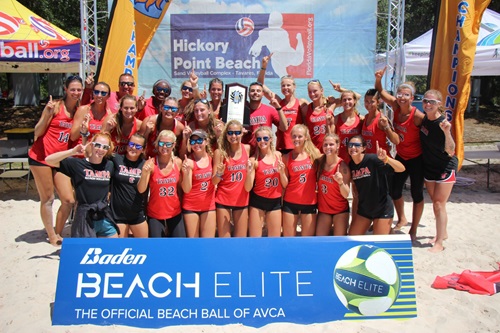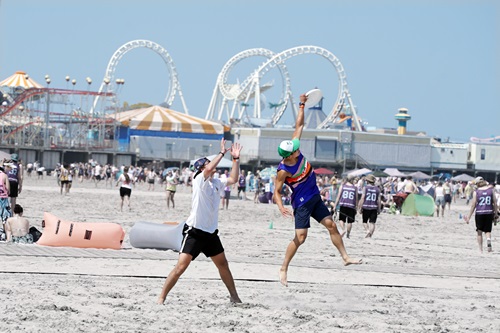
When the beach hockey event, Sticks in the Sand, moves into The Wildwoods this week, it will be just one part of a burgeoning trend of sand-based sports that are gaining more players every summer. In addition to the ever-popular beach volleyball, plenty of sports are making headway on the sand, including soccer, kickball, handball, tennis, wrestling and more.
Oh, and to those who said beach sports were a passing fad? These disciplines are kicking sand into your face. Just take a look at some of the events that are making big waves on the coastline.
The North American Sand Soccer Championships (NASSC) are almost a living contradiction: a niche sports event that takes over an entire resort town in peak season, with maximum economic results.
The event spans 30 blocks of Virginia Beach’s oceanfront and, in addition to its marquee beach events of amateur soccer and professional soccer, incorporates what are known as “sidekick sports,” events like beach volleyball, beach kickball, beach field hockey and beach flag football, to name a few.
 Over 70 vendors, two pro stadiums, a free kids’ clinic and oceanfront entertainment add to the appeal. The 2023 event made almost $14 million and consumed 8,000 room nights, setting the stage for the 30th anniversary of the championship, held from June 7-9, 2024. On average, the event attracts between 800 and 900 teams, with more than 10,000 athletes and more than 35,000 spectators.
Over 70 vendors, two pro stadiums, a free kids’ clinic and oceanfront entertainment add to the appeal. The 2023 event made almost $14 million and consumed 8,000 room nights, setting the stage for the 30th anniversary of the championship, held from June 7-9, 2024. On average, the event attracts between 800 and 900 teams, with more than 10,000 athletes and more than 35,000 spectators.
The event has also muscled its way into the international scene.
“Our pro events serve as the main place for talent identification for the U.S. National Beach Soccer Teams,” event co-organizer Matt Whalen told SDM in 2023. “We work really closely with the U.S. Soccer Federation, and athletes have tryouts so that they can showcase their talents. In fact, the head coach for the men’s team was a player in our event for years and years. Now, he comes here because he can leverage the fact that we have athletes coming in from all across the country. People just flock to us to take part in the event because it can be a springboard into a pro soccer career.”
And, says Tighe O’Sullivan, CEO and Tournament Director of Pro-Am Beach Soccer, the growth across other sand sports is evident.
“We have seen growth in beach lacrosse, beach Ultimate, beach volleyball, as well as beach rugby – they’re all really popular.”
And, he notes, finding a new location for Pro-Am Beach Soccer doesn’t depend on having an ocean.
“It’s not always about having a beach – it’s more about having the sand. We can do this anywhere where there’s a large enough plot of sand. We’ve been aiming to hold events in landlocked cities like Kansas City, Jefferson Parish in Louisiana, Cedar Rapids, Iowa – there are some amazing places and they would do a great job at hosting.”
 What is essential, he adds, is having a local club that can be a partner to the event.
What is essential, he adds, is having a local club that can be a partner to the event.
Then there’s beach tennis, played on a court the same size that of beach volleyball. While the ITF has a pro Beach Tennis Tour, it is not a sport widely contested in the U.S.; in fact, while there are several highly ranked players from Puerto Rico, the only American man in the top 100, Carlos Rivera, comes in at number 96.
But it hasn’t stopped cities in the USA from offering the sport. In fact, in Montgomery county, Maryland, Nike Missile Park offers a sand court that can accommodate both beach volleyball and beach tennis.
“The adjustable net system is going to be a unique amenity that allows the sand court at Nike Missile to be shared by different sports groups. Most sand courts in the county park system only accommodate volleyball. The net at Nike Missile can be lowered for beach tennis and then raised for volleyball,” said Chuck Kines, park planner.
Another beach tennis court can be found in Southborough, Massachusetts, and in other areas scattered around the U.S. Beach tennis, though, really does not have the grip on America that beach volleyball and beach soccer have attained.
Then there’s beach wrestling, organized in this country by USA Beach Wrestling. While it’s not in the Olympics, it is in the University World Games (FISU). The sport is also growing at the youth level; North Carolina has become the first state to sanction beach wrestling as a high school sport.
The profile of the sport is growing internationally as well. United World Wrestling debuted its first online beach wrestling course, with information on benefits of beach wrestling, basic rules and scoring, differences between beach wrestling and the Olympic styles, how competitions are organized, as well as how bouts are organized and conducted, along with details of the Beach Wrestling World Series.
Some disciplines of sports, like beach lacrosse, are not formally sanctioned disciplines, but are played recreationally, and in non-sanctioned tournament formats at beach locations. In other sports, sand games are a mainstay. In the Wildwoods, for example, the largest Beach Ultimate Tournament in the world, celebrates 32 years as it returns to the shore on Saturday, July 27 and Sunday, July 28. Beach rugby and beach handball are sanctioned versions of those sports with specific rules, playing area dimensions and other information. Cycling, in the discipline of fat biking, can be contested on the sand as well.
 In all cases, it takes some work to transition from playing a sport on a traditional surface (a hard court, grass, etc.) to playing on the sand. Running on the sand, for example, is slower and generally contested over shorter distances (at least for athletes who are used to pavement or rubberized track surfaces).
In all cases, it takes some work to transition from playing a sport on a traditional surface (a hard court, grass, etc.) to playing on the sand. Running on the sand, for example, is slower and generally contested over shorter distances (at least for athletes who are used to pavement or rubberized track surfaces).
Coaching is different as well, since playing methods will change. Athletes playing soccer on the sand must learn to kick the ball while having their toes curled under (like a fist) to avoid injury. Fields are smaller as well.
The event space is seeing the growth of sand-based sports as well.
“We started our events in 2005 during the same week FIFA established the World Cup,” says Tighe O’Sullivan. “In the beginning we were one of three companies offering beach soccer. Now there are more than 60 events going on in the U.S. alone.”

